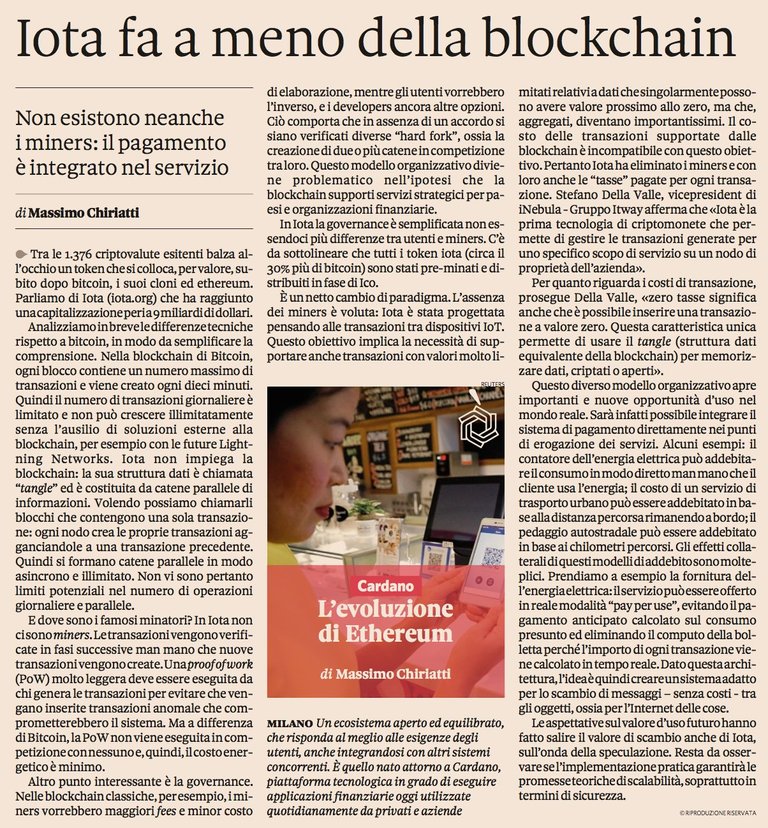Proper credits to Massimo Chiriatti for this very interesting article written for Il Sole 24 Ore (http://www.ilsole24ore.com/), I only translated this from Italian to English. -Angel Class
Iota (MIOTA) does without the blockchain
There are no miners either: payment is integrated into the service
by Massimo Chiriatti (https://twitter.com/massimochi)
Among the 1,376 existent crypto-currencies, a token is placed in the eye, by value, immediately after bitcoin, its clones and ethereum. Let's talk about Iota (www.iota.org) which has reached a capitalization of $9 billion.
Let's take a brief look at the technical differences compared to bitcoins, in order to simplify the understanding. In the Bitcoin blockchain, each block contains a maximum number of transactions and is created every ten minutes. Therefore, the number of daily transactions is limited and can not grow indefinitely without the use of solutions outside the blockchain, for example with future Lightning Networks. Iota does not use the blockchain: its structure is called "tangle" and is made up of parallel chains of information. If we want, we can call them blocks that contain only one transaction: each node creates its own transactions by hooking them to a previous transaction. Thus parallel chains are formed in an asynchronous and unlimited way. There are therefore no potential limits in the number of daily and parallel operations.
And where are the famous miners? In Iota there are no miners. Transactions are verified in successive stages as they are created. A very light proof of work (POW) must be performed by those who generate the anomalous transactions that would compromise the system. But unlike Bitcoin, the POW is not performed in competition with connection and, therefore, the energy cost is minimal.
Another interesting point is governance. In classic blockchains, for example, miners would like higher fees and lower processing costs, while users would like it, and developers still have other options. This means that in the absence of an agreement there have been several "hard fork", ie the creation of two or more chains in competition with each other. This organizational model becomes problematic in the hypothesis that the blockchain supports strategic services for countries and financial organizations.
In Iota, governance is simplified and there are no more differences between users and miners. It should be noted that all IOTA tokens (about 30% more than bitcoins) were pre-mined and distributed in the ICO phase.
It is a clear change of paradigm. The absence of the miners is desired: Iota was designed thinking about the transactions between IoT devices. This objective implies the need to also support transitions with very limited relative values which individually can have a value close to zero, but which, aggregated, become very important. The cost of transactions supported by blockchains is incompatible with this goal. Therefore Iota eliminated the miners and with them the "taxes" paid for each transaction. Stefano Della Valle, vice-president of iNebula-Itway Group (https://www.itway.com/) states that "Iota is the first encryption technology that allows managing the transitions generated for a specific service purpose on a node owned by the company".
Regarding the costs of transitions, continues Della Valle "zero taxes also means you can enter a transaction at zero value.This unique feature allows you to use the tangle (equivalent data structure of the blockchain) to store data, encrypted or open".
This different organizational model opens important and new opportunities for use in the real world. It will indeed be possible to integrate the payment system directly at the service delivery points. Some examples: the electricity meter can be directly charged for consumption as the customer uses energy; the cost of an urban transport service can be charged based on the distance traveled while remaining on board; the motorway toll can be charged based on the kilometers traveled. The side effects of these forms of payment are very numerous. Take examples of the supply of electricity: the service can be offered in real "pay per use" mode, avoiding the prepayment calculated on the presumed consumption and eliminating the bill calculation because the import of each transaction is calculated in real time . Given this architecture, the idea is therefore to create a suitable system for exchanging messages - without costs - between objects, that is, for the Internet of Things.
Expectations on the value of future use have increased the exchange value of Iota too, on the wave of speculation. It remains to be seen whether the practical implementation will guarantee theoretical promises of scalability, especially in terms of security.

Also in the same article there's a mention of Cardano (middle picture and small paragraph in bottom-middle
Cardano - The evolution of Ethereum
by Massimo Chisiatti
MILAN An open and balanced ecosystem that responds best to users' needs, also integrating with other competing systems. It is the one born around Cardano, a technological platform able to execute financial applications that are used daily by individuals and companies.
Current price as of the translation of this article is as follows:
Cardano (ADA) $0.912678 USD - 0.00006032 BTC (https://coinmarketcap.com/currencies/cardano/)
Iota (MIOTA) $3.90 USD - 0.00025784 BTC (https://coinmarketcap.com/currencies/iota/)
Congratulations @macharelo! You have received a personal award!
Click on the badge to view your Board of Honor.
Do not miss the last post from @steemitboard!
Participate in the SteemitBoard World Cup Contest!
Collect World Cup badges and win free SBD
Support the Gold Sponsors of the contest: @good-karma and @lukestokes
Congratulations @macharelo! You received a personal award!
You can view your badges on your Steem Board and compare to others on the Steem Ranking
Vote for @Steemitboard as a witness to get one more award and increased upvotes!